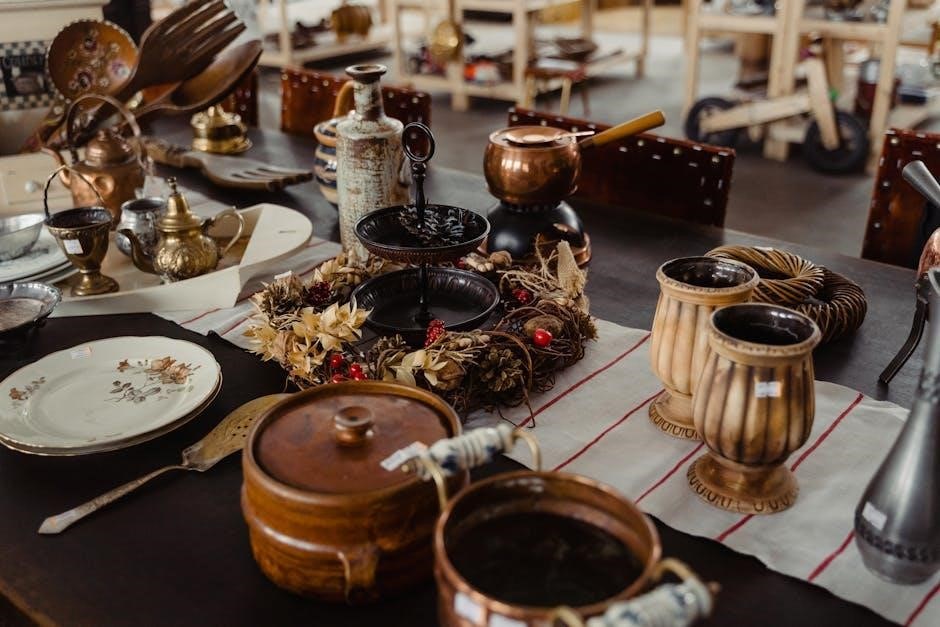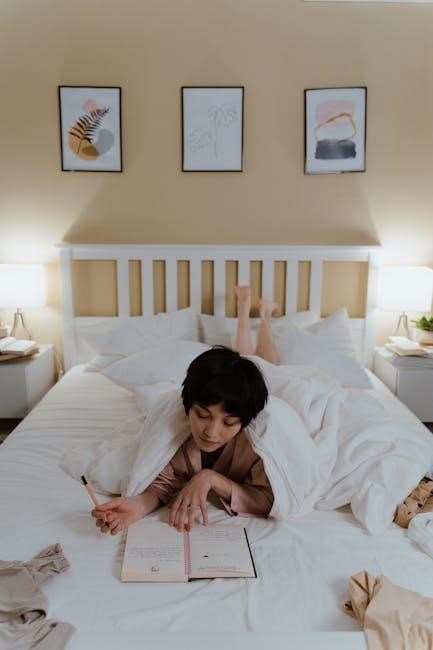Lighting transforms spaces, and choosing the right lamp is crucial for functionality and style. This guide helps you navigate size, purpose, and design to find the perfect fit.
Why Choosing the Right Lamp Matters
Choosing the right lamp is essential for balancing functionality and aesthetics in any space. The correct size and scale ensure harmony with furniture, while proper lighting purpose enhances tasks or ambiance. A well-selected lamp avoids glare, reduces eye strain, and complements room style. It also serves as a design statement, reflecting personal taste and elevating decor. With countless options, selecting the perfect lamp requires careful consideration of size, material, and light type to meet specific needs and enhance overall space functionality. This guide helps you make informed decisions for the perfect lighting solution.
Understanding Different Types of Lamps
Lamps come in various styles, each serving unique purposes. Table lamps, floor lamps, and wall lamps are common categories, with specific designs for tasks like reading or ambient lighting. Desk and bedside lamps focus on functionality, while pendant lamps add decorative flair. Understanding these types helps you identify the best fit for your space. Whether it’s for task, ambient, or accent lighting, knowing the differences ensures you select a lamp that meets your needs and enhances your room’s decor. This section explores the diversity of lamps to guide your selection process effectively.

Types of Lamps
Lamps vary widely, from table and floor lamps to wall, pendant, desk, and bedside options, each designed for specific lighting needs and spaces.
Table Lamps
Table lamps are versatile lighting solutions that enhance functionality and style in living rooms, bedrooms, and offices. They provide task lighting for reading or ambient illumination for cozy spaces. When choosing a table lamp, consider the size relative to the furniture and room proportions. The shade height should align with eye level when seated to avoid glare. Styles range from modern to traditional, with materials like ceramic, metal, or wood offering diverse aesthetic options. Proper sizing and placement ensure balanced lighting, making table lamps a practical and decorative addition to any room.
Floor Lamps
Floor lamps are versatile lighting solutions that combine functionality and style, offering both ambient and task lighting. They are ideal for rooms with limited table space and can serve as focal points in a room. Torchieres project light upward, mimicking overhead lighting, while standard shades provide accent illumination. Consider the lamp’s height and proportions relative to the room and furniture. Choose materials and designs that complement your decor, from modern metal to traditional wood. Energy-efficient options like LED bulbs are practical, and adjustable features enhance versatility. Proper placement ensures balanced lighting, making floor lamps a valuable addition to any space.
Wall Lamps
Wall lamps offer a sleek, space-saving solution for lighting, adding both functionality and style to any room. They are ideal for areas with limited floor or table space, such as hallways, bedrooms, or staircases. Available in various designs, from modern sconces to classic fixtures, wall lamps can provide ambient or accent lighting. Consider the room’s decor when choosing materials like metal, glass, or fabric. Proper installation height ensures optimal light distribution and reduces glare. Wall lamps are a practical and elegant way to enhance your home’s lighting while maintaining a minimalist aesthetic. They can also serve as decorative pieces, elevating the room’s ambiance.
Pendant Lamps
Pendant lamps are versatile lighting fixtures suspended from the ceiling, offering both style and functionality. They are ideal for corridors, kitchens, or dining areas, providing focused or ambient light. Available in various designs, pendant lamps can serve as a focal point in a room. When installing, ensure they are at least 78 inches (200cm) above the floor for general spaces and 72 inches (182cm) over kitchen islands or dining tables to avoid glare. Pendant lamps are a great way to add modern flair and tailored lighting to your home, making them a popular choice for contemporary interiors.
Desk Lamps
Desk lamps are essential for task lighting, providing focused illumination for reading, writing, or working. They are portable, versatile, and ideal for home offices, study areas, or small workspaces. When choosing a desk lamp, consider features like adjustable arms, dimmer switches, and glare-free shades to customize brightness and direction. Energy-efficient LED bulbs are recommended for long-lasting performance and reduced eye strain. The right desk lamp can enhance productivity while complementing your workspace decor, making it a practical and stylish addition to any setting.
Bedside Lamps
Bedside lamps are perfect for creating a cozy ambiance while providing essential lighting for reading or relaxation. Choose a lamp with a shade that diffuses light softly to avoid glare. Consider the size relative to your nightstand and bedroom decor; Features like touch controls or USB ports add convenience. Opt for energy-efficient bulbs to reduce energy consumption. The right bedside lamp enhances both functionality and style, ensuring a comfortable and inviting bedroom atmosphere while meeting your specific lighting needs; Proper scaling ensures the lamp complements the space without overpowering it, making it a thoughtful addition to your bedroom setup.

Factors to Consider When Buying a Lamp
Size, purpose, material, and style are key considerations. Energy efficiency, lighting type, and adjustability also matter. Ensure the lamp fits your space and meets your lighting needs effectively.
Size and Scale
Size and scale are critical when selecting a lamp. A lamp that is too large can overpower a space, while one that is too small may fail to provide adequate lighting. Consider the room’s dimensions, the furniture’s proportions, and the lamp’s intended use. For example, a bedside lamp should be tall enough to illuminate reading material without shining directly into the eyes. Measure your space and test the lamp in the room if possible. Proper scaling ensures the lamp complements the decor and functions effectively, creating a balanced and harmonious environment.
Lighting Purpose (Ambient, Task, or Accent)
Understanding the lighting purpose is essential for selecting the right lamp. Ambient lighting provides overall illumination, creating a welcoming atmosphere, while task lighting focuses on specific activities like reading or cooking. Accent lighting highlights decorative elements or areas, adding visual interest. Consider the primary function of the lamp—whether it’s to brighten a room, assist with tasks, or draw attention to a design feature. Combining these purposes can create a layered lighting scheme that enhances functionality and aesthetics. Matching the lamp’s purpose to your needs ensures it fulfills its intended role effectively.
Material and Build Quality
Material and build quality significantly impact a lamp’s durability and aesthetic appeal. Metal lamps offer modern styles and durability, while wooden lamps provide a natural, warm feel. Ceramic and glass options add elegance and uniqueness. Assess the weight and stability of the base to ensure the lamp won’t tip over. High-quality materials and craftsmanship ensure longevity. Look for sturdy electrical components and smooth switches for reliable performance. The right combination of material and build quality enhances both functionality and design, making your lamp a lasting addition to your space.
Style and Design
Style and design play a crucial role in enhancing your space’s aesthetic. Choose lamps that complement your room’s decor, whether modern, traditional, or minimalist. Consider the finish, such as brass, chrome, or wood, to match existing furniture. Ceramic and glass lamps add elegance, while metallic designs offer a sleek look. Layering lighting with table, floor, or pendant lamps creates a cohesive style. Ensure the lamp’s design aligns with the room’s purpose, like ambient lighting for living areas or task lighting for workspaces. A well-chosen lamp can be both functional and a decorative statement, personalizing your space to reflect your taste.
Energy Efficiency
Energy efficiency is a key consideration when selecting a lamp. Opt for LED or CFL bulbs, which consume less energy while providing equivalent light output. LEDs are particularly eco-friendly, lasting up to 25 times longer than incandescent bulbs. Look for lamps with dimmer switches or adjustable brightness to conserve energy further. Smart lighting options also offer energy-saving benefits by allowing you to control light usage remotely. Choosing energy-efficient lamps reduces your carbon footprint and lowers electricity bills. Always check for certifications like ENERGY STAR to ensure the lamp meets energy-saving standards. Prioritizing efficiency helps you save money and support sustainability.

Lighting Sources and Features

Modern lamps offer a range of lighting sources, from LED to halogen and incandescent bulbs. Features like dimmer switches and smart technology enhance adjustability and energy efficiency, providing tailored illumination solutions.
LED vs. Halogen vs. Incandescent Bulbs
When choosing a bulb type, consider energy efficiency, lifespan, and light quality. LEDs are the most energy-efficient, lasting up to 50,000 hours, and are environmentally friendly. Halogen bulbs offer bright, warm light but are less efficient than LEDs. Incandescent bulbs provide a cozy glow but are the least efficient and shortest-lasting. LEDs are ideal for long-term savings, while halogen bulbs are a good middle ground. Incandescent bulbs are best for ambiance but may require more frequent replacements. Each option suits different needs, so prioritize based on your preferences for efficiency, brightness, or warmth.
Dimmer Switches and Adjustability
Dimmer switches offer flexibility, allowing you to adjust brightness to suit different moods or tasks. This feature enhances ambiance and functionality, making it ideal for spaces like living rooms or bedrooms. Dimmers can also help reduce eye strain by softening harsh light. When selecting a lamp, ensure compatibility with dimmer switches, especially for LED bulbs, as not all LEDs are dimmable. Adjustability adds value by extending the lamp’s versatility, making it a practical choice for dynamic lighting needs. Consider dimmer capability to customize your lighting experience effectively.
Smart Lighting Options
Smart lighting options offer advanced control and convenience, allowing you to adjust brightness, color, and scheduling via apps or voice commands. Many modern lamps are compatible with smart home systems like Zigbee or Wi-Fi, enabling seamless integration. Energy-efficient LED bulbs are often used in these systems, providing long-lasting performance. Smart lamps can also be programmed to mimic natural daylight or create ambiance. When choosing smart lighting, consider compatibility with your existing smart home setup and desired features like color temperature tuning or timer functions. This technology enhances flexibility and personalization, making it a valuable addition to modern homes.

Lamp Shades and Diffusers
Lamp shades and diffusers are essential for controlling light direction and reducing glare. They come in various materials like fabric, glass, or metal, offering different aesthetic and functional benefits. Proper sizing ensures optimal light diffusion, while shape and material choices impact the overall style and ambiance of the space. Selecting the right shade enhances both functionality and design, making it a crucial step in your lamp-buying journey.
Choosing the Right Shade Size and Shape
Choosing the right shade size and shape is vital for both functionality and aesthetics. Measure the lamp base to ensure the shade proportionally fits, avoiding overpowering the space. The shade’s height and width should align with the lamp’s scale and the room’s dimensions. A shade that is too small may not diffuse light effectively, while one that is too large can overwhelm the area. Consider the shape—round shades soften light, while angular shapes create focused beams; Ensure the shade covers the bulb adequately to prevent glare. Proper sizing enhances light distribution and complements the room’s style, making it a critical decision in your lamp-buying process.
Materials for Shades (Fabric, Glass, Metal)
When selecting lamp shades, the material significantly impacts both aesthetics and functionality. Fabric shades offer a soft, warm glow, ideal for ambient lighting, while glass shades provide clarity and modern sophistication. Metal shades add a sleek, durable finish, often used in industrial or minimalist designs. Each material affects light diffusion and style, so consider the room’s decor and lighting needs. Fabric shades are perfect for creating a cozy atmosphere, glass shades enhance contemporary spaces, and metal shades deliver a polished, industrial look. Choose wisely to balance form and function seamlessly in your home. Proper material selection enhances both light quality and room aesthetics.
Light Diffusion and Glare Reduction
Light diffusion and glare reduction are critical for creating a comfortable and visually pleasing environment. Shades designed with diffusion in mind, such as frosted glass or textured fabrics, help soften harsh light and prevent eye strain. Proper shade sizing ensures light is evenly distributed without direct glare. Positioning lamps at eye level or slightly above minimizes glare, especially for reading or task lighting. Pendant lamps should be installed at appropriate heights to avoid casting harsh light. Balancing diffusion and glare reduction ensures optimal lighting for both functionality and aesthetics, making spaces more inviting and user-friendly. Consider these factors to enhance your lighting experience.

Decorating Tips for Lamps
Lamps are both functional and decorative, enhancing a room’s ambiance. Choose styles that complement the space, layer lighting for depth, and use unique designs to add personality.
Matching Lamps to Room Style
When selecting a lamp, consider the room’s aesthetic to ensure harmony. For modern spaces, opt for sleek materials like metal or glass, while traditional rooms may suit ceramic or wooden designs. Measure the furniture to ensure the lamp’s size complements the setup. Use lamps as decorative statements, like a vintage piece paired with a modern shade. Avoid clashing styles by aligning the lamp’s design with the room’s overall vibe. Layering lighting with table, floor, and wall lamps creates depth. Remember, lamps are functional jewelry—choose materials and designs that enhance the room’s personality while providing the right light.
Layering Lighting in a Room
Layering lighting enhances functionality and ambiance by combining ambient, task, and accent light sources. Begin with overhead or natural light for ambient illumination, then add table or floor lamps for task lighting, such as reading. Finally, incorporate accent lighting, like wall sconces or pendant lamps, to highlight decorative features. Balance the layers to avoid harsh shadows and ensure even distribution. Consider the height and placement of lamps, such as aligning table lamp shades with eye level to prevent glare. This approach creates a cohesive, inviting space that meets both practical and aesthetic needs.
Using Lamps as a Design Statement
Lamps are not just functional but also serve as decorative focal points. Choose unique designs, such as ceramic or wood bases, to add personality to a room. Mixing vintage and modern styles can create a bold statement. Consider replacing outdated shades on vintage lamps for a fresh look. Lamps like those from Circa Lighting or CB2 offer stylish options without breaking the bank. Treat lamps as “jewelry” for your space, enhancing the room’s aesthetic while providing light. This approach allows you to express your style and elevate your interior design effortlessly.

Specialized Lighting Needs
Specialized lighting includes reading lights for focused tasks, task lighting for workspaces, and SAD lamps for seasonal affective disorder, each addressing specific needs with tailored solutions.
Reading Lights

Reading lights are designed to provide focused illumination for tasks like reading or hobbies, reducing eye strain. They often feature adjustable arms and direct light sources. When choosing a reading light, consider the size of the shade relative to the bulb to ensure adequate light coverage. The lamp’s height should align with your line of sight when seated. LED bulbs are ideal for reading lights due to their energy efficiency and minimal glare. Look for a lamp with a dimmer or adjustable brightness to customize the light level. Proper positioning is key to avoid harsh glare and ensure optimal comfort during extended reading sessions.
Task Lighting for Workspaces
Task lighting is essential for workspaces, providing focused illumination for activities like writing, drafting, or computer work. Desk lamps are the most common choice, offering adjustable brightness and direction. Look for lamps with LED bulbs for energy efficiency and long lifespan. A dimmer switch or adjustable arm allows customization of light intensity. The shade size and shape should direct light without causing glare. Proper task lighting reduces eye strain and improves productivity. Consider the color temperature of the bulb, with cooler tones enhancing focus. Ensure the lamp is sturdy and proportional to the workspace to maintain a balanced setup.
SAD Lamps for Seasonal Affective Disorder
SAD lamps are designed to combat Seasonal Affective Disorder by mimicking natural daylight. They emit bright, full-spectrum light with a high lux rating (typically 10,000 lux) to regulate mood and energy. When choosing a SAD lamp, ensure it is UV-free to avoid skin irritation. Look for adjustable settings to customize brightness and color temperature. Portability is key for convenience. These lamps are especially beneficial during winter months, helping to improve mood and reduce fatigue. Consult reviews or expert recommendations to find the best option for your needs and ensure it meets clinical standards for effectiveness.

Where to Buy Lamps
Lamps can be purchased from online retailers like LampsUSA, physical stores for in-person shopping, or second-hand shops for unique, vintage options.
Online Retailers
Online retailers like LampsUSA, Circa Lighting, and Lumens offer a wide selection of lamps with detailed descriptions and customer reviews. Websites such as CB2 and Amazon provide convenient shopping experiences, often with fast shipping and easy returns. Online platforms allow you to filter by style, size, and price, making it easier to find the perfect lamp for your space. Many retailers also offer expert advice and buying guides to help you make informed decisions. Shopping online gives you access to a vast range of options and the ability to compare products from the comfort of your home.
Physical Stores
Physical stores provide a hands-on experience, allowing you to see and test lamps in person. Retailers like IKEA, Home Depot, and Bed Bath & Beyond offer a wide range of styles and brands. Visiting a store lets you assess the lamp’s size, material, and light quality firsthand. Many stores also display lamps in vignettes, helping you visualize how they fit into your home decor. Additionally, in-store experts can offer personalized advice, ensuring you find the perfect lamp for your space. This tactile shopping experience is ideal for those who prefer to see products before purchasing.
Second-Hand and Vintage Options
Second-hand and vintage lamps offer unique, eco-friendly choices for homeowners. Thrift stores, flea markets, and antique shops are great sources for one-of-a-kind pieces. Online platforms like Etsy or eBay also feature vintage lamps. When buying second-hand, inspect the lamp’s condition, ensuring it’s functional and safe. Vintage lamps often boast distinctive designs that add character to a room. Consider refinishing or updating shades to modernize older pieces. This option is ideal for those seeking sustainable, budget-friendly solutions with a touch of history and personality for their home decor.
Selecting the perfect lamp enhances functionality and style. Consider size, purpose, and design to make an informed choice. Your ideal lamp awaits—shop wisely!
Final Tips for Purchasing the Perfect Lamp
When purchasing a lamp, always measure your space and furniture beforehand to ensure proper scale. Consider the room’s purpose—ambient, task, or accent lighting—to guide your choice. Prioritize energy efficiency by opting for LED bulbs, which last longer and reduce energy costs. Don’t overlook the shade; its size, shape, and material significantly impact light diffusion and aesthetics. Layer lighting in a room for a balanced look, mixing overhead, task, and ambient sources. Finally, align the lamp’s style with your decor to create a cohesive, functional, and visually appealing environment. A well-chosen lamp can elevate your space and meet your lighting needs effectively.
Maintenance and Care for Your Lamp
Regular dusting and cleaning are essential to maintain your lamp’s functionality and appearance. Use a soft cloth to wipe down surfaces, avoiding harsh chemicals that could damage materials. For fabric shades, gently vacuum or spot clean stains. Replace bulbs as needed, ensuring compatibility with the lamp’s specifications. Avoid exposing lamps to excessive moisture or direct sunlight, which can cause discoloration or damage. Store lamps in a dry, cool place when not in use. Proper care extends the lifespan and preserves the aesthetic appeal of your lamp, ensuring it continues to illuminate your space effectively.
